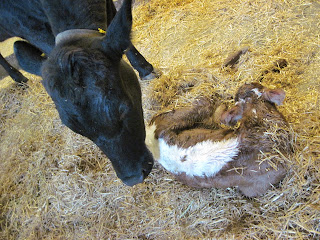"Track Record"
Calving time is always intense.

By the middle of March, when the worst bite of winter has passed, the bulls and the female "mellankalvar" (heifers that were born the previous year), have to be moved out of their winter stalls in the small animal barn,
to the "gated community" out in the open air
of the new doorless hay barn.
There they have enough shelter and deep, fresh, straw in their pens to give them warmth and protection that is more than adequate in the still brisk Spring air.
Their departure to the great outdoors makes it possible for us to power wash that area of the barn and scrub up all the necessary facilities to make room for the mothers who will be having their babies within a few weeks.
This year we had done everything we could think of to be prepared but we got hit with an
unexpected glitch
that we never could have foreseen.
unexpected glitch
that we never could have foreseen.
Normally the process goes like this:
The mother has her baby in the soft, clean straw in the birthing stall and the two of them stay together by themselves for five days. During that time the mother feeds her baby and takes care of it.
Then it's time for the baby to be outfitted with an identification eartag.
(SUPER IMPORTANT!)
The ear tags are the system that allows us to keep track of which calf has come from which mother. That birth record must be submitted to the government since we have pure-bred animals.
Once it is safely tagged, the baby is taken into a calf box where it is taught to drink milk from a bottle. For the next five days it will be fed it's mother's milk from the bottle, and have access to fresh water and hay.
Finally, when it can drink from the bottle well enough it goes to a larger pen with the other new baby calves who have also graduated through the calf-box training process.
We call that larger pen "Play Group",
where the calves will continue for eight more weeks to be bottle fed until it is time to go out into the field for the summer.
When the baby goes to the calf box, the mother goes back to the main barn and into the milking line.
We have learned that "5" is the magic number for both mother and baby.
If they are separated earlier than that the mother cries and so does her calf, but if they stay together for five full days, they both seem to make the transition just fine.
This year, with the calving in full swing, we discovered that the stash of government-issued ear tags that we had in the drawer of the big storage cabinet of the ladugårdsporten (entry to the barn), were...
SHEEP TAGS!
This was very bad news....After #119, we ran out of CALF TAGS completely.
When we called to get the next numbered sequence of tags from the government control office they said,
"Sure...we can have them to you in about three weeks"!
We made a desperate attempt to keep track on the chalkboard in the milkroom.....not working.
Meantime, the untagged calves were adding up in Play Group at an alarming rate and we were beginning to panic.
We tried giving them descriptive names like "Full-Dip" (see the one that looks like it's entire ear was dipped in ink?) or "Half-Dip" (front and center), or even "Bambi" (that would be the one in the back that is brown and white).
We tried giving them descriptive names like "Full-Dip" (see the one that looks like it's entire ear was dipped in ink?) or "Half-Dip" (front and center), or even "Bambi" (that would be the one in the back that is brown and white).
But there were just too many!
 |
| Pappa's good idea in action. |
It was Pappa who came up with the idea of taking a close-up picture of each one of them and writing the date of birth, mother's identification number, gender, etc. on the back.
Brilliant.

When the tags finally arrived Gustav and Lauren went to work and while she was feeding bottles to one group, Gustav was tagging the others.
It was such a blessing that we had the pictures with all the information.
We never would have been able to remember without them.
We never would have been able to remember without them.
Maxie always says,
"There is no problem on the farm that can't be solved",
and maybe this proves that he's right.
Look closely at the tag numbers on those fluffy calf ears and you'll see they are..
All Done!















No comments:
Post a Comment